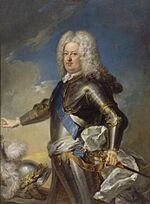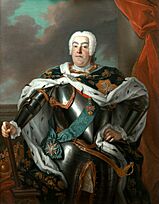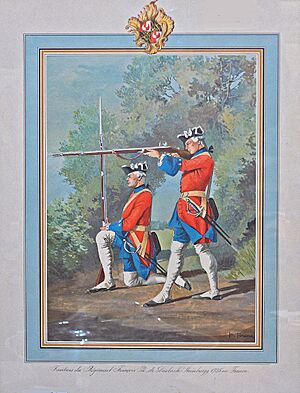War of the Polish Succession facts for kids
Quick facts for kids War of the Polish Succession |
|||||||||
|---|---|---|---|---|---|---|---|---|---|
| Part of French–Habsburg rivalry | |||||||||
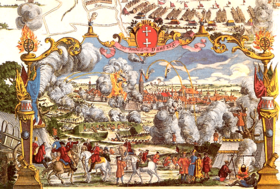 Siege of Danzig by Russo-Saxon forces in 1734 |
|||||||||
|
|||||||||
| Belligerents | |||||||||
|
|||||||||
| Commanders and leaders | |||||||||
|
|
||||||||
The War of the Polish Succession (1733–1735) was a big European conflict. It started because of a civil war in Poland–Lithuania over who would be the next king after Augustus II the Strong died. Other powerful countries in Europe got involved. They wanted to gain things for themselves.
France and Spain, both ruled by the Bourbon family, wanted to challenge the power of the Austrian Habsburgs in Western Europe. Kingdom of Prussia also joined in. Meanwhile, Saxony and Russia supported the person who eventually won the throne.
The fighting in Poland–Lithuania led to Augustus III becoming king. He was supported by Russia, Saxony, and the Habsburgs.
Most of the major battles happened outside Poland–Lithuania. The Bourbon powers, with help from Charles Emmanuel III of Sardinia, attacked Habsburg lands. In the Rhineland, France successfully took the Duchy of Lorraine. In Italy, Spain got back control of the kingdoms of Naples and Sicily. These had been lost in an earlier war. There were also battles in northern Italy, but gains there were small. Great Britain did not help Austria. This showed that their alliance was not very strong.
A first peace agreement was made in 1735. The Treaty of Vienna (1738) officially ended the war. It confirmed Augustus III as the king of Poland. His opponent, Stanisław Leszczyński, was given the Duchy of Lorraine and Duchy of Bar. These were parts of the Holy Roman Empire. Francis Stephen, who was the Duke of Lorraine, received the Grand Duchy of Tuscany as a trade-off. The Duchy of Parma went to Austria. Charles of Parma became king of Naples and Sicily.
The Bourbon family gained the most land. Lorraine and Bar became French territories. The Spanish Bourbons gained two new kingdoms: Naples and Sicily. The Austrian Habsburgs received two Italian duchies. However, Parma later went back to the Bourbons. Tuscany stayed with the Habsburgs until the time of Napoleon.
The war was very bad for Poland–Lithuania's independence. It showed that other powerful European countries controlled Poland–Lithuania's affairs. This included choosing its ruler. After Augustus III, there was only one more king of Poland. He was Stanisław August Poniatowski, who was controlled by Russia. In the end, Poland–Lithuania was divided up by its neighbors. It stopped being an independent country by the late 1700s. Poland–Lithuania also gave up its claims to Livonia. It lost direct control over the Duchy of Courland and Semigallia. This area became strongly influenced by Russia.
Contents
Why the War Started: The Polish Throne
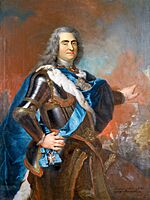
After the death of King Sigismund II Augustus in 1572, the King of Poland was chosen by the szlachta. This was a group of Polish–Lithuanian nobles. They met in a special assembly called an election sejm. The Sejm was the law-making body. It slowly limited the king's power. But the Sejm itself was often stopped by the liberum veto. This was a rule that allowed any member to block decisions.
Poland's neighbors often influenced the Sejm. By the early 1700s, this democratic system was weakening.
In 1697, Augustus II became king with support from Austria and Russia. He was removed from power by Stanisław Leszczyński in 1705. But Augustus returned four years later. Stanisław then fled to France. His daughter, Marie, married the French King Louis XV in 1725. Augustus tried to make his son, Augustus III, the next king. But he failed. This led to a fight for the throne when Augustus II died in 1733.
In 1732, Russia, Austria, and Prussia secretly agreed in the Treaty of the Three Black Eagles. They decided to oppose both Stanisław and Augustus III. Instead, they wanted to support Manuel of Portugal.
This dispute happened as the alliance between Britain and France was breaking down. This alliance had been important in Europe since 1714. The Peace of Utrecht had kept France and Spain separate. But Louis XV of France and his uncle Philip V of Spain were close. They had even fought against each other in the War of the Quadruple Alliance (1718–1720).
When Cardinal Fleury became France's chief minister in 1726, he wanted a closer relationship with Spain. The birth of Louis, Dauphin of France in 1729 seemed to ensure the two countries would stay separate.
Fleury supported Stanisław. He hoped to weaken Austria. He also wanted to secure the Duchy of Lorraine for France. Lorraine was a very important area. France had occupied it many times before. The current duke, Francis Stephen, was expected to marry Emperor Charles's daughter, Maria Theresa. This would bring Austria dangerously close to France. At the same time, Philip V of Spain wanted to get back Italian lands. These had been given to Austria in 1714. This led to the secret Pacte de Famille (Family Pact) between France and Spain in 1733.
Choosing a New King: The Election of 1733
Augustus II died on February 1, 1733. France started building up its army along its borders. The Holy Roman Emperor also gathered troops near Poland. He even moved soldiers from the Duchy of Milan to do this. Prince Eugene of Savoy had advised the Emperor to prepare for war against France. But only small steps were taken to improve defenses.
The French ambassador in Warsaw, Marquis de Monti, convinced two powerful Polish families, the Potocki and Czartoryski families, to support Stanisław. Teodor Andrzej Potocki, who was a high-ranking church leader and temporary ruler after Augustus's death, called a meeting in March 1733. At this meeting, delegates decided that no foreigners could be candidates for king. This meant both Manuel of Portugal and Augustus II's son, Frederick August II, were out.
However, Frederick August made deals with Austria and Russia in July 1733. To get Russian support, he gave up any Polish claims to Livonia. He also promised Russia's ruler, Anna of Russia, that she could choose the next leader of the Duchy of Courland and Semigallia. This was a Polish territory. To the Austrian Emperor, he promised to recognize the Pragmatic Sanction of 1713. This document was meant to ensure that Maria Theresa, the Emperor's oldest child, would inherit the Austrian throne.
In August, Polish nobles met to elect the new king. On August 11, 30,000 Russian troops entered Poland. They wanted to influence the election. On September 4, France openly supported Leszczyński. He was elected king by 12,000 delegates on September 12.
But a smaller group of nobles, about 3,000, supported by Russian troops, elected Frederick August II as King of Poland on October 5. He became Augustus III. Even though this was a minority group, Russia and Austria recognized Augustus as king. They wanted to keep their influence in Poland.
On October 10, France declared war on Austria and Saxony. King Louis XV was joined by his uncle, King Philip V of Spain. Philip hoped to gain Italian lands for his sons from his second marriage. He wanted Mantua for his older son, Don Carlos. Don Carlos was already Duke of Parma and expected to get Tuscany. Philip also wanted the Kingdoms of Naples and Sicily for his younger son, Don Felipe. These two Bourbon kings were also joined by Charles Emmanuel III of Sardinia. He hoped to gain lands from the Austrian duchies of Milan and Mantua.
Austria's Difficult Position
When the war began, Austria hoped for help from Great Britain and the Dutch Republic. But both countries decided to stay neutral. British Prime Minister Sir Robert Walpole said that their alliance with Austria was only for defense. He argued Austria was the one attacking this time. Some British people wanted to help Austria, but Walpole kept Britain out of the war.
The Dutch, led by Grand Pensionary Simon van Slingelandt, tried to help make peace. They did not want war near their borders. The previous wars against France had been very costly for the Dutch. In early 1733, it seemed the Dutch Republic might go to war with Prussia. Emperor Charles VI tried to get the Dutch to join Austria. But the Dutch stayed neutral. However, the threat of war forced the Dutch Republic to make its army bigger.
France did not want to upset Britain and the Dutch Republic. So, they carefully avoided fighting in the Austrian Netherlands. Dutch troops were stationed there. They also avoided parts of the Holy Roman Empire that might draw Britain or the Dutch into the conflict.
On Austria's southern border, France made a secret deal in November 1733. This was the Treaty of Turin with Charles Emmanuel. France then prepared for military actions in northern Italy. France also made another secret deal, the Treaty of the Escorial, with Spain. This promised French help for Spain to conquer Naples and Sicily. France also tried to get Sweden and the Ottoman Empire to join the war to support Stanisław, but this did not work.
So, Austria was mostly alone on its southern and western borders. Their Russian and Saxon allies were busy fighting in Poland. The Emperor also did not trust Frederick William I of Prussia, who offered only a little help. There were also problems within the Holy Roman Empire. Charles-Albert of Bavaria wanted to become the next Emperor. He signed a secret deal with France in November 1733. He tried to stop other rulers from helping the Emperor, but he had limited success. While Britain did not help directly, the Electorate of Hanover, where George II was also a ruler, was willing to help. On April 9, 1734, an "imperial war" was declared against France. This meant all states in the Holy Roman Empire had to participate.
Battles and Campaigns
Fighting in Poland
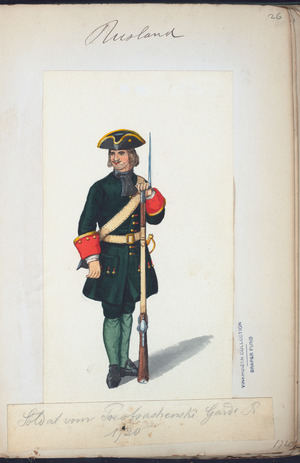
Russian troops, led by Peter Lacy, quickly captured Warsaw, the capital city. They put Augustus in place as the possible new king. Stanisław had to flee to Danzig (now Gdańsk). There, a Russian-Saxon army surrounded him. This army was led by Field Marshal Burkhard Christoph von Münnich. Danzig gave up in June 1734. Stanisław had to escape again, first to Königsberg and then to France.
This ended the main fighting in Poland. But foreign troops stayed there as Augustus dealt with Stanisław's supporters. A group of nobles who supported Stanisław formed the Confederation of Dzików in late 1734. Their leader, Adam Tarło, tried to fight the Russian and Saxon troops, but they were not successful. In a meeting called the Pacification Sejm in June–July 1736, Augustus was officially confirmed as King of Poland.
Battles in the Rhineland
After France declared war on October 10, they started fighting three days later. They invaded the Duchy of Lorraine. They also attacked the imperial fortress at Kehl, which was across the Rhine river from Strasbourg. France took control of both areas in a few weeks. France could not attack Austria directly. They did not want to invade the German states in between. This might have brought Britain and the Dutch into the war. So, France made its position stronger in Lorraine. Then, they moved their troops back across the Rhine for the winter.
The Emperor gathered his forces to respond to the French attacks. He started calling up the Army of the Holy Roman Empire. They set up a defense line at Ettlingen, near Karlsruhe. In the spring of 1734, French forces managed to get around this line. Prince Eugene of Savoy had to move his troops back to Heilbronn. This opened the way for the French army, led by the Duke of Berwick. They attacked the imperial fort at Philippsburg. It fell after a two-month siege in July 1734. Eugene, who was with Crown Prince Frederick of Prussia, tried to help the fort. But he never made strong attacks because the French army was very large. Also, his own troops were not very good. Berwick was killed by a shell during the siege of Philippsburg.
French armies kept moving along the Rhine, reaching Mainz. But the imperial army grew larger. It even included Russian troops who had helped capture Danzig. This army stopped France from besieging Mainz. Eugene then went on the attack. A force of 30,000 soldiers, led by Friedrich Heinrich von Seckendorff, crossed the Rhine. They started pushing the French back towards Trier. They defeated them at Clausen in October 1735. This was one of the last battles before the first peace terms were agreed upon.
Fighting in Italy
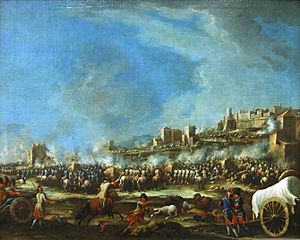
French and Savoyard troops, more than 50,000 strong, entered Milanese territory on October 24. They met very little resistance. The Austrian forces there were only about 12,000. By November 3, the city of Milan had surrendered. But the Austrian governor, Count Wirich Philipp von Daun, still held the fortress. France's great general, the Duke de Villars, joined Charles Emmanuel in Milan on November 11.
Villars wanted to move quickly against Mantua. This would secure the mountain passes against Austrian reinforcements. But Charles Emmanuel did not trust his French allies. He wanted to secure Milan first. The army spent the next three months clearing out Austrian forces from other fortified towns. Villars tried to get Don Carlos of Parma to join the attack on Mantua. But Carlos was focused on fighting in Naples. Villars started moving towards Mantua, but Charles Emmanuel held back. The army made little progress.
In early May, an Austrian army of 40,000, led by Count Claude Florimond de Mercy, crossed the Alps. They threatened to attack the French army from behind. Villars stopped his advance on Mantua. He tried to stop the Austrian army from crossing the Po River. Villars was frustrated by Charles Emmanuel's delays. He left the army on May 27. He became ill on his way back to France and died in Turin on June 17.
Mercy's forces tried many times to cross the Parma River in June. They finally crossed late that month. They approached the city of Parma. The allied forces, now led by French marshals de Broglie and Coigny, were dug in there. In the Battle of Colorno and a bloody battle near Crocetta on June 29, the Austrians were pushed back. Mercy was killed, and his second-in-command, Frederick of Württemberg, was wounded. Charles Emmanuel returned the next day to take command. He again delayed, not immediately chasing the retreating Austrians.
The Austrians retreated to the Po River. They received more troops and were put under the command of Field Marshal Königsegg. After two months of no action, Königsegg launched a surprise attack on Coigny's headquarters at Quistello on September 15. He almost captured Coigny. Two days later, the French moved back to Guastalla. A group of almost 3,000 French soldiers was surrounded and captured by the Austrians. On September 19, Königsegg attacked the allied position at Guastalla. In another bloody fight, he was pushed back. Frederick of Württemberg was killed. Königsegg retreated across the Po River. He took a defensive position. Charles Emmanuel again did not use his victory to his advantage. When he finally moved most of the allied army to Cremona, the Austrians advanced. Both armies then went into winter camps in December 1734.
In southern Italy, the Austrians chose to defend many fortresses. But they were badly defeated. Don Carlos gathered an army mostly of Spaniards, with some French and Savoyard troops. He moved south through the Papal States. His army went around the main Austrian defense at Mignano. This forced the Austrians to retreat into the fortress at Capua. Don Carlos was welcomed into Naples by the city leaders. The Austrian ruler had fled. The fortresses held by Austrians in the city were quickly captured.
While blocking the largest Austrian fortresses at Capua and Gaeta, a large part of the allied army chased the remaining Austrian forces. These forces finally tried to make a stand in late May. They were defeated at Bitonto. Capua and Gaeta were then properly surrounded. Austrian fortresses in Sicily were quickly taken over. Gaeta surrendered in August. Capua held out until November. Its commander, Otto Ferdinand von Abensberg und Traun, finally gave up when he ran out of ammunition. Charles Edward Stuart, who was under 14 at the time, also took part in the French and Spanish siege of Gaeta. This was his first experience in battle.
The armies in northern Italy suffered a lot during the winter. Many soldiers died from disease or left the army. For the 1735 campaign, the allied forces in northern Italy were led by the Duke de Noailles. He had become a Marshal after his success in the Rhine campaign. Spanish forces joined them in May, after their victories in the south. Königsegg retreated into the Bishopric of Trent. But he left the fortress city of Mantua well-defended.
At this point, disagreements between the allies became clear. Spain claimed Mantua. It also refused to promise Milan to Charles Emmanuel. Because of this, Charles Emmanuel refused to let his siege equipment be used against Mantua. So, the French-Spanish army could only blockade the city. When Charles Emmanuel pulled his forces out, the allies had to retreat. The struggling Austrians took advantage of this. They eventually got back most of Milan in November with little opposition.
Ending the War: The Peace Treaty

As early as February 1734, Britain and the Dutch had offered to help with peace talks. By early 1735, ideas for peace were being shared. As 1735 went on, Austria was not in a good position to keep fighting. France was worried about Russian troops possibly arriving on the Rhine. So, negotiations continued through the summer of 1735.
A first peace agreement was finally made in October 1735. It was officially confirmed in the Treaty of Vienna in November 1738. Augustus was officially confirmed as king of Poland. Stanisław was given Lorraine as a trade-off. Lorraine would pass to France after his death, through his daughter. The former Duke of Lorraine, Francis Stephen, was made the heir to the Grand Duchy of Tuscany.
Charles of Parma gave up Parma, which went to Austrian rule. But he was well-rewarded by being confirmed as king of Naples and Sicily. Charles Emmanuel III of Sardinia received lands in the western part of the Duchy of Milan. These included Novara and Tortona.
Even though fighting stopped after the first peace agreement in 1735, the final peace deal had to wait. It waited until the death of the last Medici Grand Duke of Tuscany, Gian Gastone, in 1737. This allowed the land exchanges agreed upon in the peace settlement to happen.
The French and their allies hoped for good relations with the Austrians. They now also recognized the Pragmatic Sanction. This document would allow Emperor Charles's daughter, Maria Theresa, to become ruler after him. However, this promise did not last. The French later decided to intervene to divide the Habsburg lands after Charles died in 1740. But gaining Lorraine for the former Polish king was a lasting benefit for France. It became directly ruled by France when Stanisław died in 1766.
Stanisław signed the document giving up his throne in 1736. Augustus III announced a general pardon. Michał Serwacy Wiśniowiecki was greatly rewarded. The king made him the Grand Hetman and commander-in-chief of the Grand Duchy of Lithuania.
More to Explore
 In Spanish: Guerra de sucesión polaca para niños
In Spanish: Guerra de sucesión polaca para niños
- War of the Spanish Succession
- War of the Austrian Succession
- List of wars of succession in Europe


